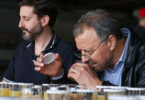Mike Doyle is back in Griffin for a rare day in his office. He’s spent the last 24 hours responding to media requests for comment on the elimination of the country’s only pathogen screening program for produce from the 2013 federal budget proposal. The Boston Globe, Washington Post and Huffington Post are among the outlets that have come to him as an expert in the field.
“It’s the radar gun that keeps the industry aware of regulatory oversight, and if that’s eliminated, we don’t have a program that will keep the industry in check,” Doyle says from behind a desk covered in stacks of papers, many from federal government agencies.
Without it, states or other federal agencies will have to find scarce resources to monitor foods for harmful bacteria, such as salmonella and E. coli, which can cause severe illness and even death.
As director of the Center for Food Safety on UGA’s Griffin campus, Doyle is a key player in the country’s effort to prevent the spread of harmful bacteria and parasites in the food supply. Researchers at the center work with federal agencies like the Food and Drug Administration and the Centers for Disease Control and Prevention to identify contaminants and trace them back to their sources. The majority of their work is in helping the food industry better protect itself from contamination, from the fields to the consumer.
It is a daunting task given the many types of harmful microbes that can contaminate the food supply in the field, during processing and even during transportation.
“Salmonella is carried in the intestinal tracts of animals,” Doyle explains. “It is transmitted through manure. Feces is sometimes used to fertilize soil. It can also get into the irrigation water.”
In recent years, a major problem with food contamination has been in produce, not just meat and poultry, which were once the main culprits.
“People are eating more produce and there are riskier practices today,” Doyle says. “It’s being processed and marketed without all the interventions needed to ensure safety.”
According to the CDC, each year an estimated one in six Americans (about 48 million people) contracts a foodborne illness. Of those, about 128,000 are hospitalized and 3,000 die.
A 2006 E. coli outbreak in prepackaged spinach left more than 200 people sick, 102 of them hospitalized. Five people died as a result of the illness.
More recently, in the fall of 2011, 34 people died after eating cantaloupe contaminated with listeria. It was the second deadliest outbreak of bacterial foodborne illness in the U.S., behind only the 1985 outbreak of listeriosis in cheese, which killed 52.
Doyle emphasizes that most people don’t die from foodborne illnesses. Those who do are usually older adults or people with a compromised immune system. Still, E. coli, salmonella and listeria can leave victims violently ill, many requiring hospitalization.
And the number of cases associated with eating produce has increased in recent years as people have become more health conscious and are eating more fruits and vegetables.
Doyle and others at the Center for Food Safety work with the food industry to help keep its products safe. More than 50 major food processors, retailers and restaurant chains across the U.S. have contributed money to the center to help pay for the research. They often seek out Doyle when there is a potential problem with a product.
Rhona Applebaum, vice president and chief scientific and regulatory officer for the Coca-Cola Co., said she relies on the center because its recommendations are based on sound scientific evidence.
In 2004, the company had to defend itself against a non-scientific study that indicated fecal coliforms found in ice tea were E. coli bacteria. Though scientists at Coca-Cola knew that the coliforms were harmless and not E. coli, they called in Doyle to make their case. He had scientific data that proved the tea was not contaminated.
“We needed a good scientist and one that could talk to lay folk,” says Applebaum, who worked alongside Doyle at the University of Wisconsin in the early 1980s. “We had somebody with credibility, somebody who engendered confidence.”
The outbreak associated with spinach in 2006, all of it from a single farm in California, was most likely contaminated by wild pigs that had gotten into the field rooting for grubs and defecating on the plants. Once the source was determined, spinach growers implemented deterrents such as fencing the fields.
But Doyle warns that finding solutions to the problem is becoming more difficult as more and more food is produced outside the U.S. In Mexico City, the largest city in a country that exported more than $4 trillion worth of produce to the U.S. in 2008, only 10 percent of the wastewater is recycled; 90 percent is dumped untreated into the river, which is sometimes used to irrigate crops.
Much of the orange juice sold in the U.S. now comes from Brazil, while more than 60 percent of the apple juice consumed in this country is produced in China, Doyle says. While the FDA requires producers in other countries to adhere to the same standards as U.S. producers, Doyle says there is a question of who provides the oversight to ensure that equivalent food safety standards are being followed. In addition to helping large corporations protect their products, the center also works with Georgia farmers to keep homegrown foods safe.
Larry Beuchat, a distinguished research professor at the Griffin center, is back at work following retirement, looking at preventing salmonella contamination in pecans.
There never has been a salmonella outbreak associated with eating pecans, Beuchat says, but that doesn’t mean there can’t be. Beuchat began his work with pecans in the 1970s but left it because there didn’t seem to be much of a threat to the industry. However, he returned to his research in recent years after salmonella outbreaks occurred from contaminated almonds.
“That was a wake up call for the tree nut industry,” Beuchat says.
Much of his research of late has involved looking at how the pecans are processed once they are harvested. He has tested sanitizers in water used to condition pecans in their shells before they are cracked. He also is investigating whether an organic material in the “pith” of the nut, which is toxic to salmonella, can be used to protect the kernels against contamination.
“We’ve learned a lot in the last five years,” he says.
Despite his familiarity with foodborne illnesses, Doyle says he eats most foods, but steers clear of those that that carry a higher risk of contamination-raw oysters, raw vegetable sprouts, raw milk and precut, prepackaged produce.
As for eating out, he recommends McDonald’s. After two E. coli outbreaks in 1982 the fast food giant worked closely with Doyle to develop practices that would better safeguard its food.
“McDonald’s wanted to bullet-proof its system from foodborne illnesses,” Doyle says. “From my perspective, McDonald’s is one of the safest places to eat in the world.”
One success story out of the Center for Food Safety in Griffin is the development in 2010 of a microbial wash for food that would greatly reduce the risk of foodborne illness.
Doyle and Tong Zhao, an assistant research scientist at the center, produced the wash, which kills pathogens on fruits and vegetables as well as on kitchen counters, cutting boards and food processing equipment in commercial settings.
Many times more powerful on foods than commercially available chlorine-based antimicrobials, the wash kills food pathogens one minute after application and has been deemed safe by the U.S. Food and Drug Administration and the European Union food industry. It does not affect the appearance, flavor or odor of foods, and it increases the shelf life of produce.
The technology, which was incorporated into FIT®L Food and Vegetable Wash products by the UGA Research Foundation, can also be used in food processing and transportation facilities, hospitals and restaurants-and potentially as a food additive in butters, creams and ground meats.
Doyle and Zhao received the 2010 UGA Inventor’s Award for their product. Learn more about FIT®L and where to purchase it at http://www.tryfit.com.
Doyle, who was recently named a National Academy of Inventors Fellow, is the lead inventor of multiple technologies in the area of food safety. His patented inventions relate to the use of probiotic bacteria to control E. coli infection in cattle, listeria contamination of food processing facilities, and salmonella and campylobacter in poultry and poultry products. While at UGA, Doyle has six issued U.S. patents along with several foreign patents.





